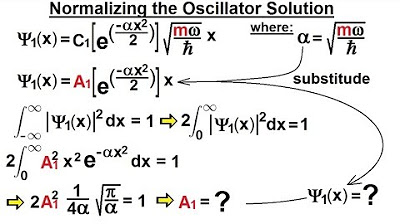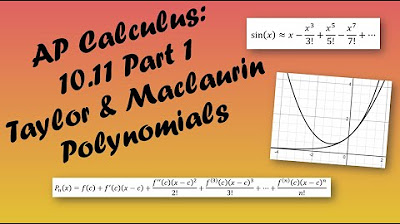Physics - Ch 66 Ch 4 Quantum Mechanics: Schrodinger Eqn (57 of 92) Calculating Hermite Polynomial?
TLDRThe transcript outlines the process of calculating Hermitian polynomials, starting from the 0th state and progressing to higher states. It demonstrates the derivation of the first three polynomials using derivatives of the function e^(-x^2). The explanation is detailed, showing the step-by-step mathematical operations involved in obtaining the polynomials for N=0, N=1, and N=2. The lecture also hints at the complexity involved in deriving polynomials for higher states and the importance of normalizing these functions for a complete solution to the quantum mechanical oscillator problem, as derived from the Schrödinger equation.
Takeaways
- 📚 The lecture introduces the calculation of Hermitian polynomials using the differential operator method.
- 🌟 For N=0, the 0th Hermitian polynomial is derived as 1, by applying the 0th derivative to the function e^(-x^2).
- 🔢 For N=1, the 1st Hermitian polynomial is calculated as 2x, obtained by taking the first derivative and simplifying the expression.
- 📈 For N=2, the 2nd Hermitian polynomial is found to be 4x^2 - 2, after taking the second derivative and simplifying the result.
- 🧠 The pattern for calculating Hermitian polynomials involves taking successive derivatives of the function e^(-x^2).
- 🔄 The process of calculating Hermitian polynomials becomes more complex with increasing values of N.
- 🌐 The lecture also mentions the importance of normalizing these polynomials for a complete solution to the quantum mechanical oscillator problem.
- 📊 The normalization of the Hermitian polynomials is a topic that will be covered later in the lecture series.
- 📖 The script is based on a mathematical approach to solving the Schrödinger equation for the harmonic oscillator.
- 🎓 The content is suitable for individuals with a strong background in mathematics and quantum mechanics.
- 🔑 Key to understanding the script is recognizing the pattern in the differentiation process and the application of exponential functions.
Q & A
What is the starting point for calculating the Hermitian polynomials?
-The starting point for calculating the Hermitian polynomials is with N equals 0, which represents the 0 state.
What is the expression for the 0 state of the Hermitian polynomial?
-The expression for the 0 state of the Hermitian polynomial is (-1)^0 times e^(x^2) times the 0 derivative of e^(-x^2), which simplifies to 1.
How does the 0 state derivative of a function relate to the function itself?
-The 0 state derivative of a function relates to the function itself by the fact that any number to the 0 power is 1, so the 0 derivative of a function simply returns the function.
What is the expression for the 1 state Hermitian polynomial?
-The expression for the 1 state Hermitian polynomial is 8 sub 1 of x, which is (-1)^1 times e^(x^2) times the first derivative of e^(-x^2), simplifying to 2x.
How do you find the second derivative of e^(-x^2)?
-To find the second derivative of e^(-x^2), you first take the first derivative, and then take the derivative of that result again, which involves applying the chain rule twice.
What is the expression for the 2 state Hermitian polynomial?
-The expression for the 2 state Hermitian polynomial is (-1)^2 times e^(x^2) times the second derivative of e^(-x^2), which simplifies to 4x^2 - 2.
How does the pattern of Hermitian polynomials help in calculating them for higher N states?
-The pattern of Hermitian polynomials shows that for each higher N state, you need to take the Nth derivative of e^(-x^2) and apply the appropriate power of (-1) and x terms, which helps in systematically calculating the polynomials for higher N values.
What is the significance of normalizing the Hermitian polynomials?
-Normalizing the Hermitian polynomials is important because it ensures that the functions form an orthogonal set, which is a requirement for solving the quantum mechanical oscillator problem derived from the Schrödinger equation.
Why does the process of finding Hermitian polynomials become complicated for higher N states?
-The process becomes complicated for higher N states because each step involves taking more derivatives and dealing with increasingly complex algebraic expressions, which requires more time and effort.
What is the role of the Hermitian polynomials in quantum mechanics?
-In quantum mechanics, Hermitian polynomials play a crucial role in describing the wave functions of particles in a harmonic oscillator, which is a fundamental system in quantum mechanics.
How does the lecture script help in understanding the mathematical structure of Hermitian polynomials?
-The lecture script provides a step-by-step derivation of the Hermitian polynomials, which helps in understanding the mathematical structure by showing the process of obtaining each polynomial from the previous one and highlighting the pattern that emerges.
Outlines
📚 Introduction to Hermitian Polynomials
This paragraph introduces the calculation of Hermitian polynomials, starting with the case where N equals 0, which represents the 0th state. The explanation begins with the derivation of the first polynomial, highlighting that the 0th derivative of a function returns the function itself, leading to the result of 1 for the polynomial. The process is then repeated for N equals 1, resulting in the second polynomial. The explanation is detailed, walking through the steps of taking derivatives and applying them to the exponential function. The paragraph concludes with the derivation of the third polynomial, emphasizing the pattern and method used to obtain the Hermitian polynomials.
🔢 Derivation and Normalization of Hermitian Polynomials
This paragraph continues the discussion on Hermitian polynomials, focusing on the process of deriving them for higher values of N, specifically N equals 4. It acknowledges the increasing complexity as more derivatives are taken but reassures that the pattern becomes clear with practice. The paragraph also mentions the importance of normalizing these polynomials to complete the solution for the quantum mechanical oscillator, which is derived from the Schrödinger equation. The speaker encourages the audience to stay tuned for the next part of the lecture, where normalization will be demonstrated.
Mindmap
Keywords
💡Hermitian Polynomials
💡Derivative
💡Exponential Function
💡Normalization
💡Quantum Mechanics
💡Harmonic Oscillator
💡Schrödinger Equation
💡Power
💡Integral
💡Wave Function
💡Pattern
Highlights
Introduction to the calculation of Hermitian polynomials.
Derivation of the 0th Hermitian polynomial with N equals 0.
Explanation of the 0th derivative resulting in the original function.
Calculation of the 1st Hermitian polynomial for N equals 1.
Derivation process involving the first and second derivatives.
Result of the 1st Hermitian polynomial: 2x * e^(-x^2).
Derivation of the 2nd Hermitian polynomial for N equals 2.
Complex calculation involving multiple steps of differentiation.
Final expression for the 2nd Hermitian polynomial: 4x^2 - 2.
Observation of the pattern for obtaining Hermitian polynomials.
Mention of the process becoming more complicated for higher N values.
Connection to the quantum mechanical oscillator derived from the Schrödinger equation.
Promise of an upcoming explanation on how to normalize the Hermitian polynomials.
Emphasis on the importance of understanding the normalization process for a complete solution.
The lecture provides a step-by-step method for calculating Hermitian polynomials.
The use of derivatives to construct higher order Hermitian polynomials.
The significance of the Hermitian polynomials in quantum mechanics.
Transcripts
Browse More Related Video

Physics - Ch 66 Ch 4 Quantum Mechanics: Schrodinger Eqn (56 of 92) What is a Hermite Polynomial?

Physics - Ch 66 Ch 4 Quantum Mechanics: Schrodinger Eqn (55 of 92) Solution of the Oscillator

Physics - Ch 66 Ch 4 Quantum Mechanics: Schrodinger Eqn (60 of 92) Normalizing the Oscillator

AP Calculus BC Lesson 10.11 Part 1

Writing Polynomial Functions With Given Zeros | Precalculus

Complex Numbers: Operations, Complex Conjugates, and the Linear Factorization Theorem
5.0 / 5 (0 votes)
Thanks for rating: